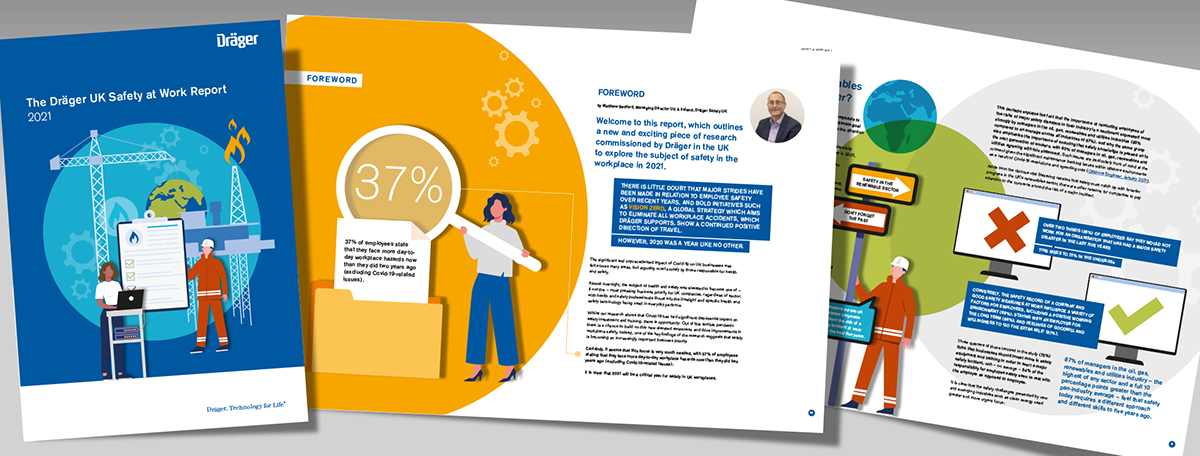Matthew Bedford, Managing Director at medical technology solutions specialist, explores the subject of safety in the workplace in 2021
Safety at work
There is little doubt that major strides have been made in relation to employee safety over recent years, and bold initiatives such as vision zero, a global strategy which aims to eliminate all workplace accidents, which Dräger supports, show a continued positive direction of travel.
In the UK we have commissioned a report which outlines a new and exciting piece of research that explores the subject of safety in the workplace in 2021.
The significant and unprecedented impact of Covid-19 on UK businesses was felt across many areas, but arguably most acutely by those responsible for health and safety.
Almost overnight, the subject of health and safety was elevated to become one of – if not the – most pressing business priority for UK companies, regardless of sector, with health and safety professionals thrust into the limelight.
Whilst our research shows that Covid-19 has had significant detrimental impact on safety investment and training, there is opportunity: Out of this terrible pandemic there is a chance to build on this new elevated awareness and drive improvements in workplace safety.

Excluding Covid-19-related issues – 37% of employees stating that they face more day-to-day workplace hazards now than they did two years ago.
There are significant training backlogs and an urgent need to re-focus safety efforts away from the all-consuming Covid-19 safety concerns, and back to the somewhat neglected core day-to-day hazards faced by many people in workplaces.
There are still many unknowns, not least what the future of work will look like. But it seems unlikely that working patterns will revert to pre-pandemic styles of full-time office-based work, perhaps shifting even more towards gig-earning style employment.
This will have wide-reaching impacts on safety at work and will undoubtedly raise questions about responsibility for employee safety, and whilst many companies will take their responsibilities as seriously as ever, others may not.
In addition, advances in technology and the increasingly sophisticated use of data, offer hugely positive potential for employee safety, and if used correctly, have enormous possibilities to help improve the way in which people work in hazardous environments.
The lack of awareness around potential workplace impairment resulting from mainstream medical treatments for illnesses such as anxiety and depression is an issue particularly highlighted in our research. It is vitally important that the understanding of such issues is better realised by those responsible for people’s safety at work and must be part of the subsequent debate around the issue by UK businesses.

When it comes to safety at work, the range of potential topics to explore – and their broader implications on wider business issues – are numerous.
“With our research we have tried to identify some of the key topics of the moment, and I very much hope that this provides useful information and insight when it comes to safety at work in the UK.” Matthew Bedford, Managing Director UK & Ireland, Dräger Safety and Medical UK
Executive summary
Workplace safety is more significant today than ever as businesses become more aware and more concerned about the impact of both physical and psychological workplace hazards on the wellbeing of their employees and how this affects the reputation of their business or industry. This has been borne out by our research which shows that workplace safety is a more important priority than it was two years ago.
However, in order to understand the impact of workplace safety, both human and economic, it is important to consider the extent of the issue. Figures show (Health and Safety Executive (HSE) and National Statistics 2020) that in 2020/19 there were 0.7 million workers who sustained a non-fatal injury in the workplace and that 1.6 million workers were suffering from work related ill-health. While from an economic perspective, 32.5 billion working days were lost due to work-related ill health.
This survey of managers and employees, across a wide range of sectors, explored broad-ranging factors. This report details these findings, from the residual impact of the pandemic to the opportunity presented by new technology.
It is clear from the findings that safety in the workplace embraces a much wider remit than it did just five years ago. As a result, this report considers emerging hazards and safety perceptions and asks how prepared the UK plc is to address the challenges ahead.
The conclusion is that there is a will to improve workplace safety and a solid foundation to build on but, particularly considering the consequences of the pandemic, more needs to be done in the workplace safety arena, in terms of investment in training and safety technology; in recognising new risks and how to support employees and in capitalising on data driven by new technology which can be used to proactively improve safety standards.
Read the full report here.
For more information please contact: med-marketing.uk@draeger.com.
Please note: This is a commercial profile
© 2019. This work is licensed under a CC BY 4.0 license.











